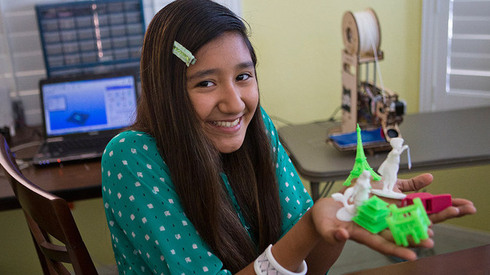In previous posts on tech learning games and projects, and on robots, we mentioned a lot of cool kit–toys and technology. If you’re interested in trying this kit but can’t buy it yourself, consider some of these options:

Danielle Delgado wants to be a robotics engineer but for now uses her 3-D printer to make gifts for friends. Michael Chow/The Republic (AZ Central)
PUBLIC LIBRARIES: they’re struggling to stay digitally relevant and a few Toronto libraries are setting up digital innovation centers with community 3D printers alongside their community computers.
This story about twelve-year-old Danielle Delgado’s (pictured above) presentation of her 3D printer to kids at Guadalupe Branch Library of the Maricopa County Library District says that this Arizona library will be hosting a weekly 3-D printing club this summer.
Take these articles with you when you ask your local library to get involved too. And why not suggest Goldiblox, littleBits and Bigshot as well (see 8 tech learning games and projects)?
SCHOOLS: like libraries, schools are building up their digital and STEM toolkits. Make your school aware of the types of options available, or better yet, pick one and urge your school to get it on a trial basis.
Here’s some evidence that schools are successfully using 3D printers–and if they can get on with 3D printers, surely they can get on with any of the projects we mentioned earlier.
– 3D printer manufacturer Makerbot is lobbying for a 3D printer in every school and have set up donation mechanisms for groups to support the effort
– 5 tips from a teacher who is using 3D printers with students. The teacher’s blog is here. It has these pictures of the teacher and her classroom makerspace:


– In California teachers are learning to build 3D printers for the classroom.
SCOUTS (girls and boys): these groups are also on the STEM bandwagon (see girlscout blurb in our other post) and local troops and state branches might be open to getting this kit for their scouts.
THE SHARING ECONOMY: instead of getting these for yourself, go in with a few other families and create a mini “toy library” that you share. Some communities already have toy or tool lending libraries, where this type of kit might fit.
Here’s a story about a Toronto tool library that also loans kitchen equipment and runs 3D printing workshops.
In fact, we are currently in the middle of “Sharing Spring”, a global movement to collaborate, participate, rethink, swap, celebrate and create. A number of cities are organizing sharefests — and what better topic for a sharefest than fun tech kit that also happens to be educational?
LOCAL MAKER/HACKING GROUPS: many major cities now have groups dedicated to helping people, often including kids, make and hack electronics and computer code. For example in london there’s Technology Will Save Us and Seattle has Makerhaus, Metrix: Create Space (and others, if you can believe it).
Good Luck, and let us have your experiences and ideas in the comments.












